Development of a New Unique Concept for Accurate Sample Measurement across Different Microscope Based Molecular Spectroscopy System
October 2, 2023
Introduction
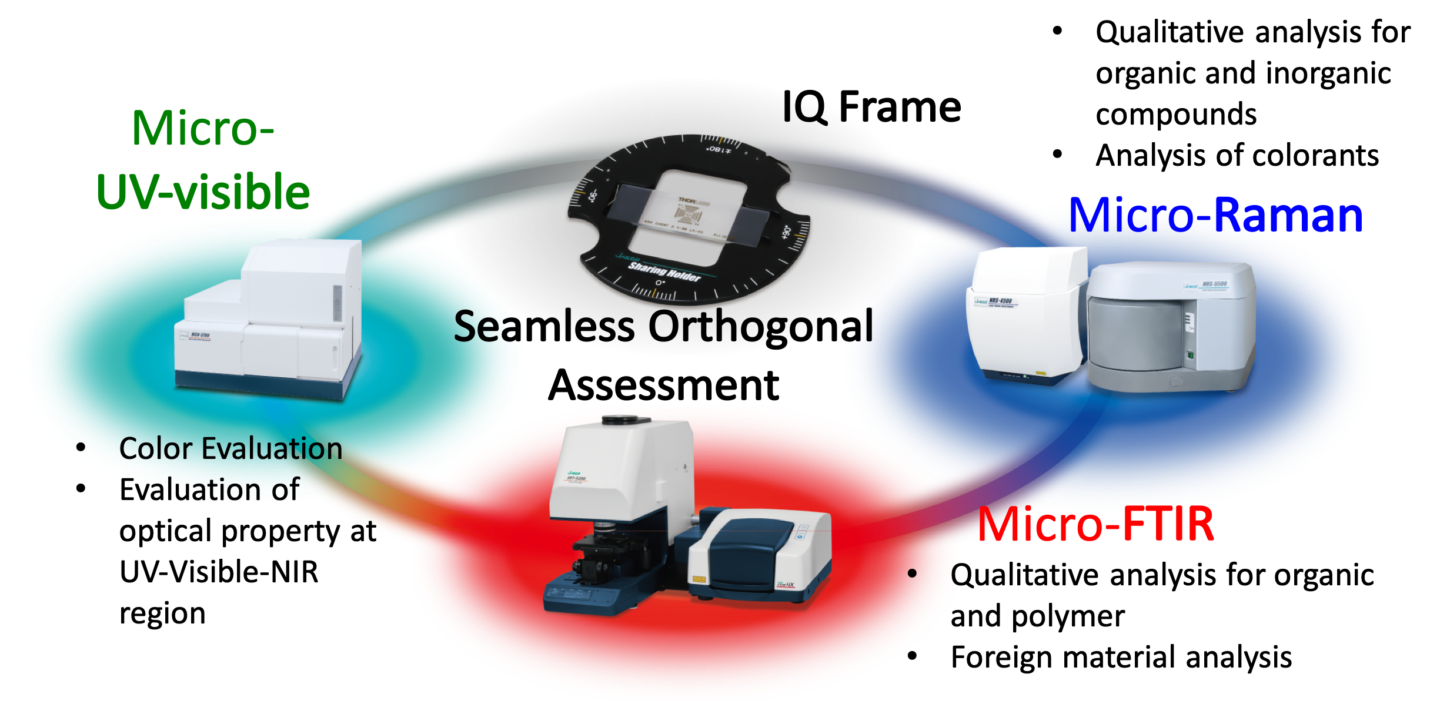 Raman and infrared spectroscopy are well known as complementary techniques to study molecular structure and molecular function. In addition, UV-visible spectroscopy represents an optional orthogonal assessment. Although orthogonal assessment has been proven to be useful in quality analysis, it is a challenge to accurately synchronize the measurement position at the microscopic level across different systems, such as Raman, IR and/or UV-visible microscopy. To overcome this barrier, we have developed ‘IQ Frame’, a sample holder that can be easily transferred among Raman, FTIR and UV-visible micro-spectrometers.
Raman and infrared spectroscopy are well known as complementary techniques to study molecular structure and molecular function. In addition, UV-visible spectroscopy represents an optional orthogonal assessment. Although orthogonal assessment has been proven to be useful in quality analysis, it is a challenge to accurately synchronize the measurement position at the microscopic level across different systems, such as Raman, IR and/or UV-visible microscopy. To overcome this barrier, we have developed ‘IQ Frame’, a sample holder that can be easily transferred among Raman, FTIR and UV-visible micro-spectrometers.
In this poster, some applications included imaging measurement using IQ Frame and the features of these systems are introduced.
Features
- Shared sample holder for orthogonal assessment by micro-spectrometers
- Exact position matching is performed following two steps; First, using measurement coordinates stored in a spectrum data file, roughly select the measurement position. Second, using the image stored in the measurement data file and the live visible image, fine adjustment can be made to the stage until the sample position is perfectly matched to the previous measurement.
Experimental
Application 1: Orthogonal Assessment of Micro Fabrics by UV-Visible, Raman and FTIR Micro-Spectrometers
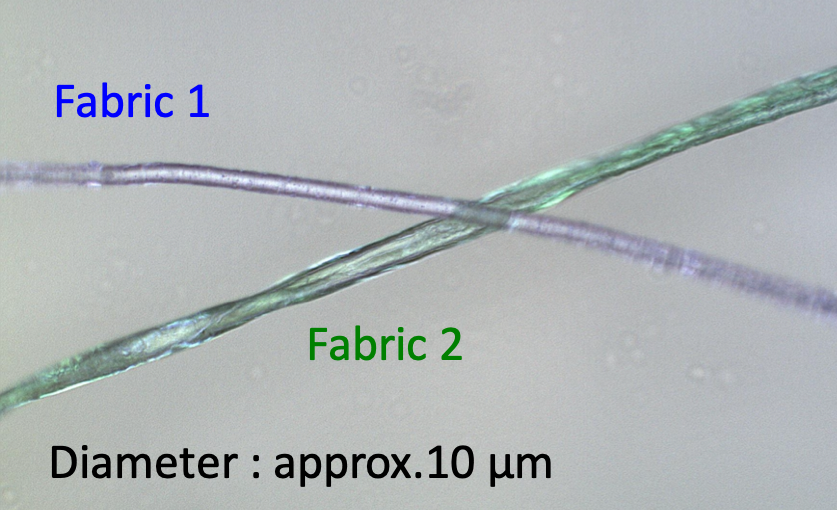
Sample Colored ( green, blue ) fabrics
Method Using IQ Frame, measured identical position of each fabric by UV-visible, Raman and FTIR
Results UV-Vis: Contributed to determine excitation laser wavelength for application of resonance Raman
-
-
-
- Identified their color
- Raman: Identified their colorant (dye)
- IR: Identified their chemical composition
-
-
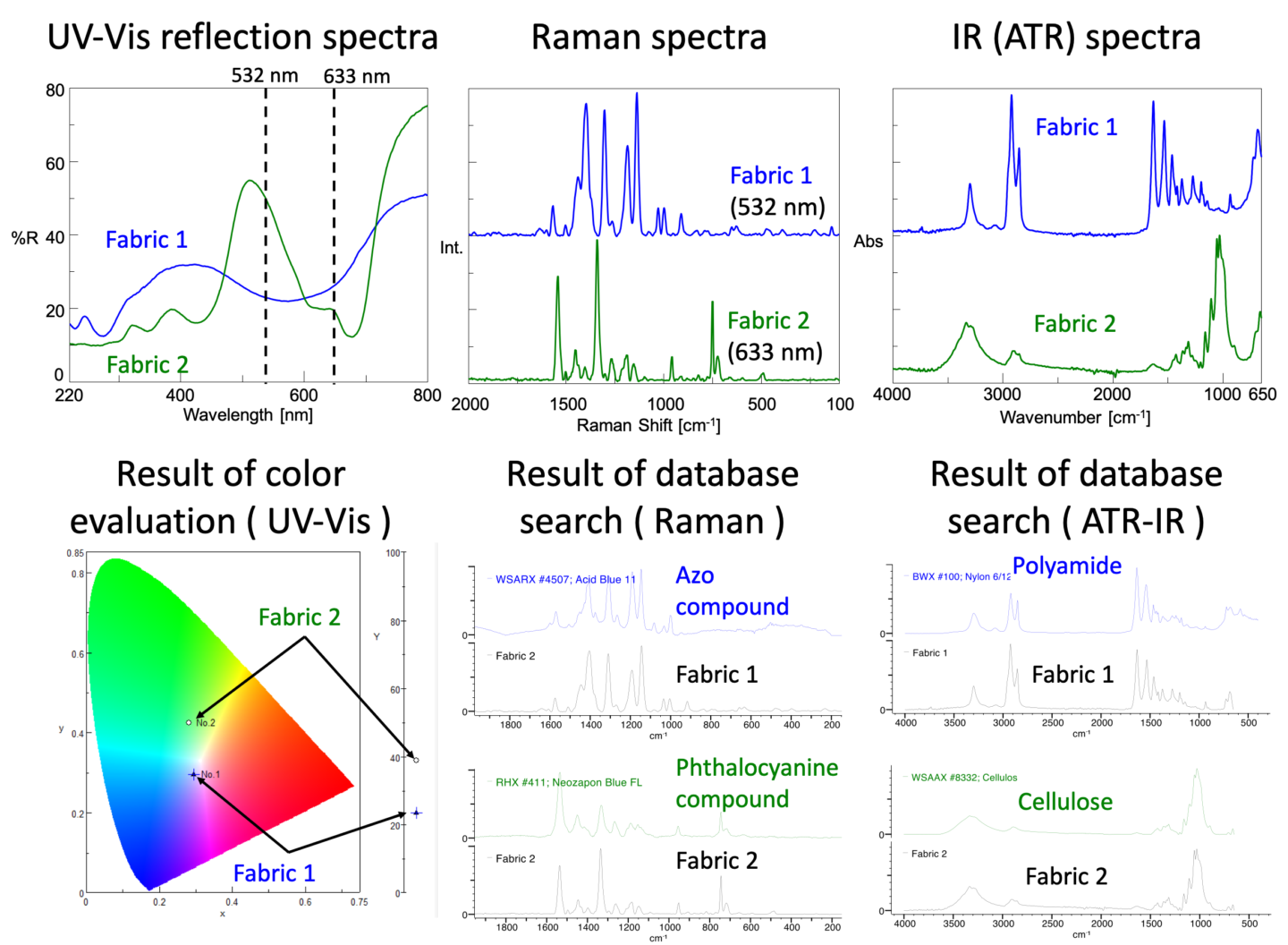
Micro-UV-visible spectra were used to analyze the fabric colors. In addition, the UV-visible spectra were used for determination of the excitation laser wavelength for Raman measurement. In the measurement of these samples, the laser wavelength close to their absorption maximum ( 532 nm for Fabric 1 and 633 nm for Fabric 2 ) are selected. From the Raman data, we could identify information about the dyes using the phenomenon of resonance Raman. Lastly, using FTIR with micro-ATR measurement, the chemical composition of the fabrics could be determined.
Application 2: Complementary Imaging Analysis of Plastics by Raman and FTIR Micro-Spectrometers
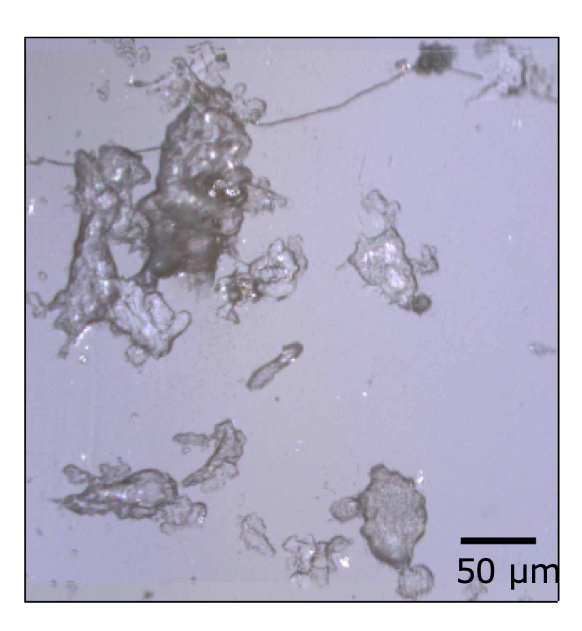
Sample Plastic particles embedded and pressed in KBr plate
Method Using IQ Frame, imaging measurement are performed by Raman and FTIR micro-spectrometer at the identical position.
Results Using both Raman and IR enabled to detect 6 components. Because protein could be detected by only IR due to fluorescence in Raman and carbon could be detected by only Raman though four types of polymers could be detected by both Raman and IR.
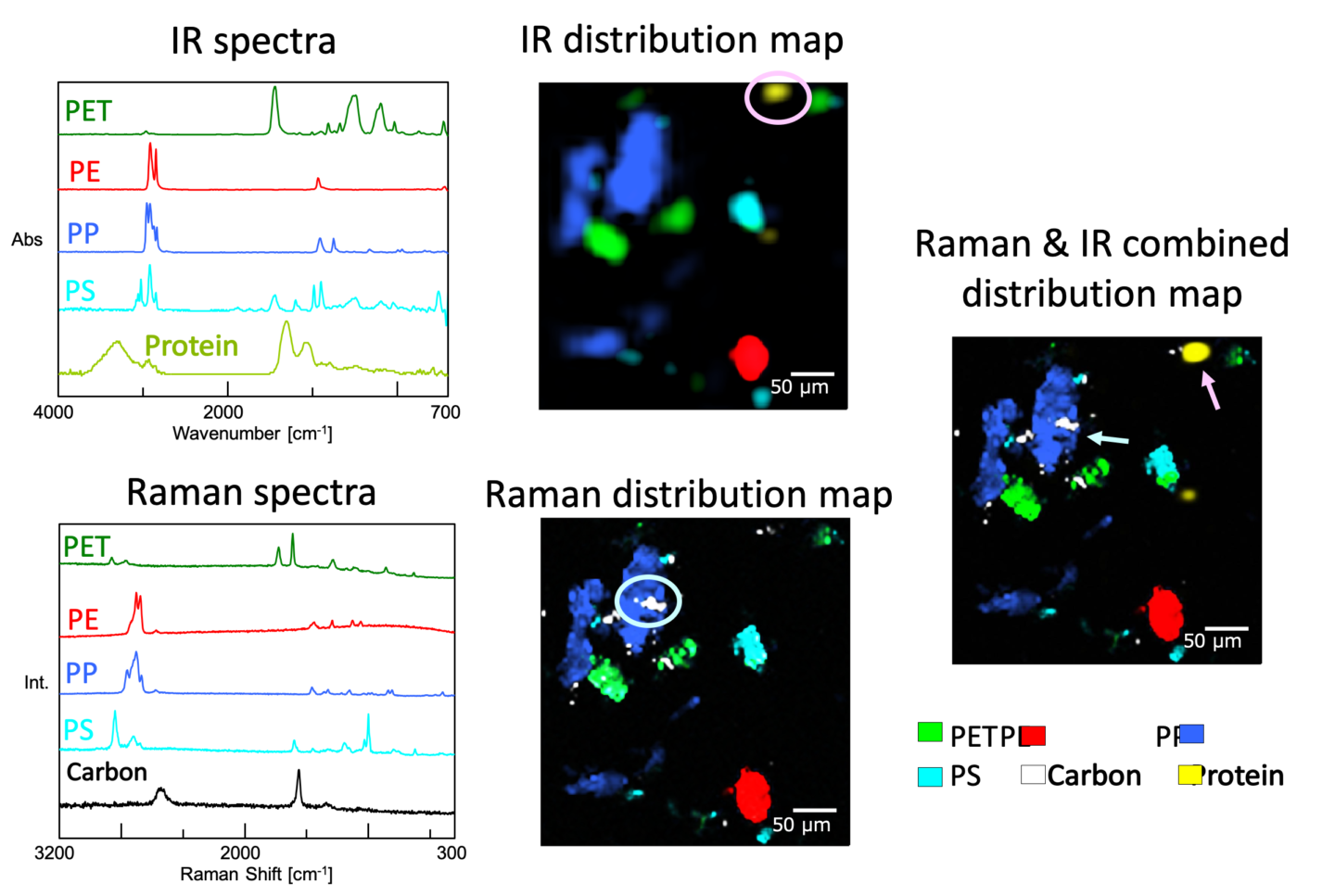
Keywords
Raman, infrared spectroscopy, molecular structure, UV-Visible, micro-spectrometers, orthogonal assessment, IQ Frame, FTIR
Results
- ‘IQ Frame’ is designed for seamless analysis among JASCO Raman, FTIR and UV-visible microscopes.
- ‘IQ Frame’ Enables seamless analyses among micro-spectrometers based on coordinates information of measurement point and coincidence of visible images between each measurement.
- Applications for complementary imaging and orthogonal assessment by multiple micro-spectrometers are introduced.
References
Authors: Carlos Morillo, Kohei Tamura, Yuji Higuchi, Erika Taira, Kento Aizawa, Satoko Suzuki, Ken-ichi Akao

Development of a New Unique Concept for Accurate Sample Measurement across Different Microscope Based Molecular Spectroscopy System
Introduction
 Raman and infrared spectroscopy are well known as complementary techniques to study molecular structure and molecular function. In addition, UV-visible spectroscopy represents an optional orthogonal assessment. Although orthogonal assessment has been proven to be useful in quality analysis, it is a challenge to accurately synchronize the measurement position at the microscopic level across different systems, such as Raman, IR and/or UV-visible microscopy. To overcome this barrier, we have developed ‘IQ Frame’, a sample holder that can be easily transferred among Raman, FTIR and UV-visible micro-spectrometers.
Raman and infrared spectroscopy are well known as complementary techniques to study molecular structure and molecular function. In addition, UV-visible spectroscopy represents an optional orthogonal assessment. Although orthogonal assessment has been proven to be useful in quality analysis, it is a challenge to accurately synchronize the measurement position at the microscopic level across different systems, such as Raman, IR and/or UV-visible microscopy. To overcome this barrier, we have developed ‘IQ Frame’, a sample holder that can be easily transferred among Raman, FTIR and UV-visible micro-spectrometers.
In this poster, some applications included imaging measurement using IQ Frame and the features of these systems are introduced.
Features
- Shared sample holder for orthogonal assessment by micro-spectrometers
- Exact position matching is performed following two steps; First, using measurement coordinates stored in a spectrum data file, roughly select the measurement position. Second, using the image stored in the measurement data file and the live visible image, fine adjustment can be made to the stage until the sample position is perfectly matched to the previous measurement.
Experimental
Application 1: Orthogonal Assessment of Micro Fabrics by UV-Visible, Raman and FTIR Micro-Spectrometers

Sample Colored ( green, blue ) fabrics
Method Using IQ Frame, measured identical position of each fabric by UV-visible, Raman and FTIR
Results UV-Vis: Contributed to determine excitation laser wavelength for application of resonance Raman
-
-
-
- Identified their color
- Raman: Identified their colorant (dye)
- IR: Identified their chemical composition
-
-

Micro-UV-visible spectra were used to analyze the fabric colors. In addition, the UV-visible spectra were used for determination of the excitation laser wavelength for Raman measurement. In the measurement of these samples, the laser wavelength close to their absorption maximum ( 532 nm for Fabric 1 and 633 nm for Fabric 2 ) are selected. From the Raman data, we could identify information about the dyes using the phenomenon of resonance Raman. Lastly, using FTIR with micro-ATR measurement, the chemical composition of the fabrics could be determined.
Application 2: Complementary Imaging Analysis of Plastics by Raman and FTIR Micro-Spectrometers

Sample Plastic particles embedded and pressed in KBr plate
Method Using IQ Frame, imaging measurement are performed by Raman and FTIR micro-spectrometer at the identical position.
Results Using both Raman and IR enabled to detect 6 components. Because protein could be detected by only IR due to fluorescence in Raman and carbon could be detected by only Raman though four types of polymers could be detected by both Raman and IR.

Keywords
Raman, infrared spectroscopy, molecular structure, UV-Visible, micro-spectrometers, orthogonal assessment, IQ Frame, FTIR
Results
- ‘IQ Frame’ is designed for seamless analysis among JASCO Raman, FTIR and UV-visible microscopes.
- ‘IQ Frame’ Enables seamless analyses among micro-spectrometers based on coordinates information of measurement point and coincidence of visible images between each measurement.
- Applications for complementary imaging and orthogonal assessment by multiple micro-spectrometers are introduced.
References
Authors: Carlos Morillo, Kohei Tamura, Yuji Higuchi, Erika Taira, Kento Aizawa, Satoko Suzuki, Ken-ichi Akao

 Download This Application
Download This Application